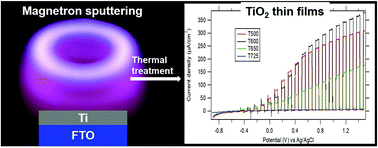Transparent rutile TiO2 films prepared by thermal oxidation of sputtered Ti on FTO glass†
Abstract
TiO2 films were prepared via a two-step fabrication process, i.e. deposition of Ti films by magnetron sputtering on an FTO glass substrate followed by thermal oxidation at 600–725 °C. The investigated parameters were Ti layer thickness, temperature of oxidation and deposition conditions (pre-treatment and substrate heating). Such TiO2 films have a rutile structure and contain metallic Sn which is the result of a thermal reaction at the interface between SnO2 and Ti at temperatures above 500 °C. A calcination temperature of 600 °C is optimal for fabricating TiO2 films with significant photoelectrochemical response. Heating of the FTO substrate during magnetron sputtering deposition of Ti films results in a significant improvement of the compactness of the TiO2 films. A similar but not so pronounced improvement was observed for the TiO2 films deposited on the FTO substrate pre-treated with radio-frequency plasma under Ar–O2 and N2–H2 atmosphere. The observed correlation between the increased content of Sn in the TiO2 films and compactness of the TiO2 films supports the explanation of both positive effects by better adhesion of the Ti films to the FTO substrate.

- This article is part of the themed collection: Solar chemistry & photocatalysis: environmental applications – SPEA10


 Please wait while we load your content...
Please wait while we load your content...